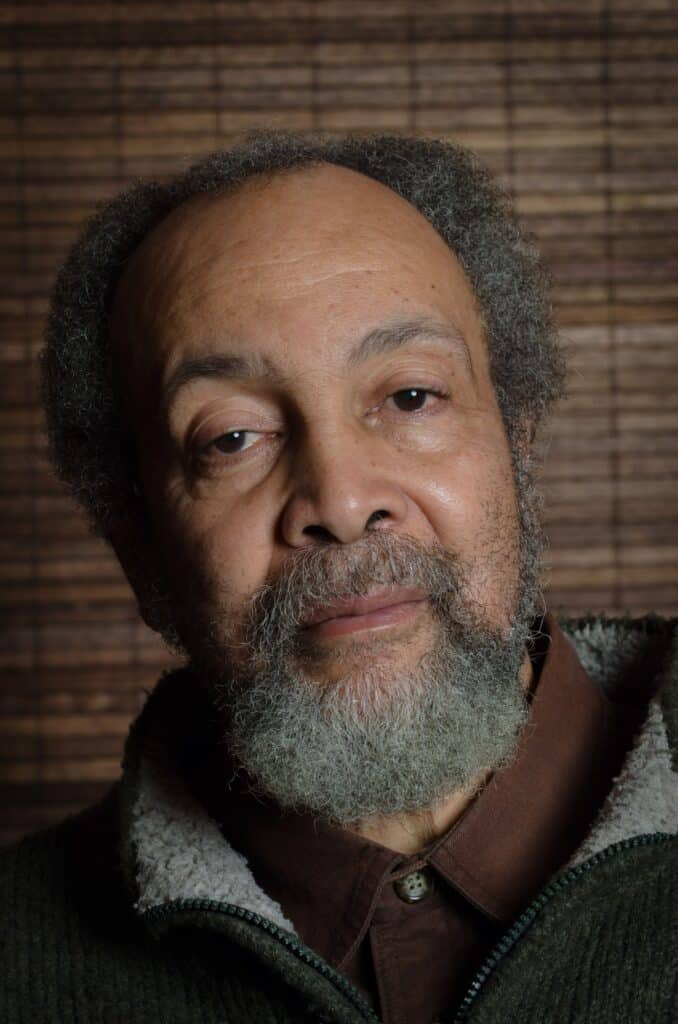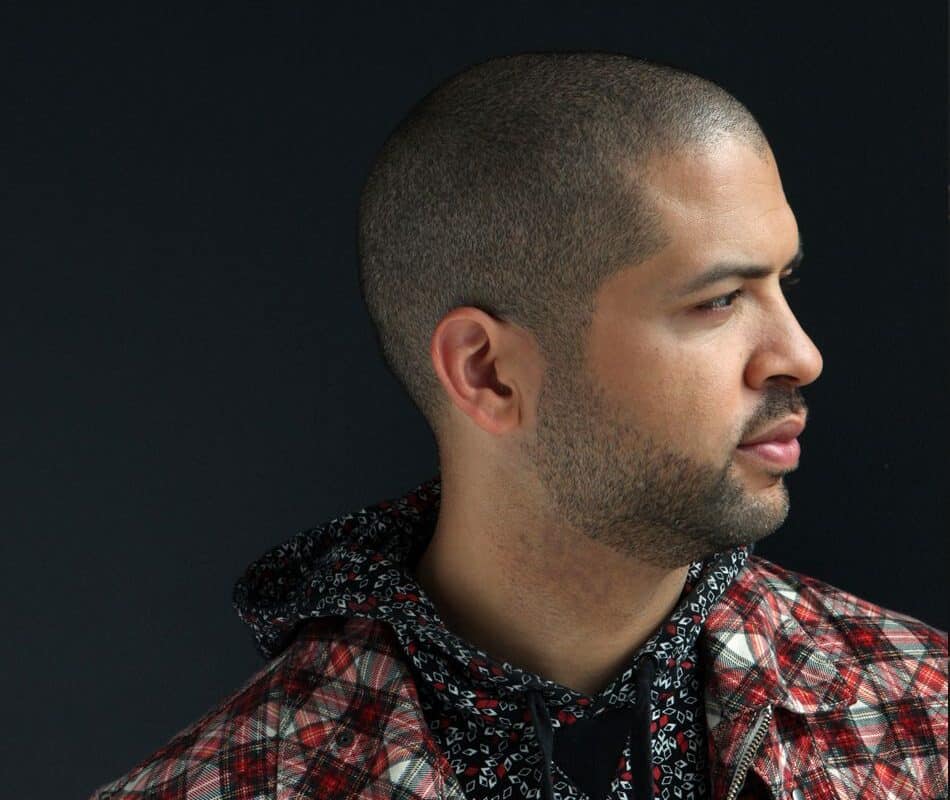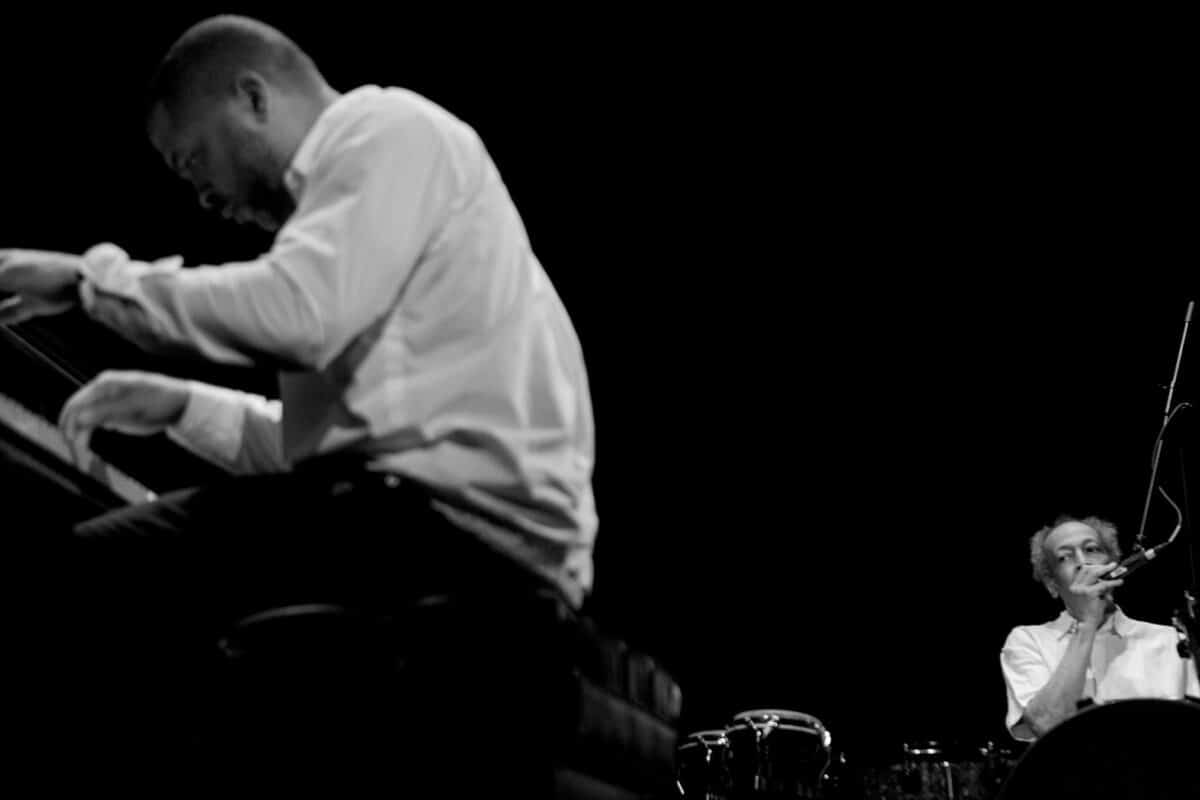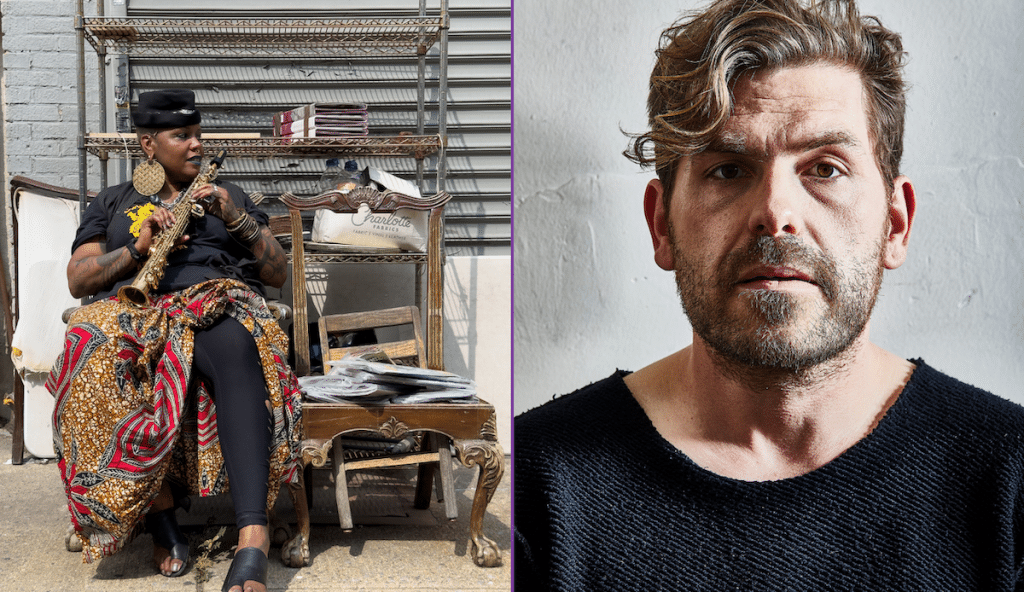CMA Duos: Milford Graves & Jason Moran
The drummer and pianist compare notes on their years of studying, teaching, and improvising.

Jason Moran and Milford Graves performed together for the first time this past March at the Big Ears Festival in Knoxville, Tennessee. There were no rehearsals prior—only conversations, during which the two artists laid the groundwork for a musical dialogue that many regarded as the festival’s best.
Born thirty-four years apart, Moran and Graves emerged from disparate scenes and circumstances, but they share a relentless curiosity and a deep reverence for history. Moran has blazed an influential trail by pushing jazz tradition unapologetically forward, incorporating an ever-widening wake of ideas from outside his chosen genre—and outside music itself—to create far-ranging new work. At the same time, he’s determinedly mined the past for ideas and inspiration, re-contextualizing and reinventing the timeless elements in a song by Schubert, the pioneering proto-jazz of James Reese Europe, or the electric vitality in Monk’s Town Hall Concert to help build important bridges to the future.
Graves, a singular percussionist as well as herbalist, martial artist, researcher, and gardener, has been a revelatory force since the mid-60s. Adapting the improvisational prerogatives of free jazz—with the great New York Art Quartet and, later, behind saxophonist Albert Ayler—Graves developed an utterly unique polymetric percussion language, rejecting the limited timekeeping role of the drummer to instead forge a mix of bruising energy, stark unpredictability, and heightened listening. The world is only beginning to catch up with his achievements, a reckoning recently accelerated by Jake Meginsky’s absorbing documentary Full Mantis. Additionally, the percussionist’s long out-of-print 1977 classic trio album Bäbi has just been reissued by Corbett Vs. Dempsey, alongside a full, previously unissued session by the same group.
The following conversation took place the morning after theit duo performance at Big Ears. The interview has been edited and condensed.

JM: One of things we talked about, a while ago, was that I do these projects where I remake the stages that were once around, like the Savoy Ballroom stage. Then we started talking about Slug’s [Saloon], because I just made a version of that. You talked about playing there, and last night, as we were playing, it came up for me—how do you emit energy? It’s a durational thing. How do you balance the energy, how do you push it, how do you conserve or pull it in? And you talked about playing at Slug’s. Somebody came and told you, ‘You ain’t gonna be able to play that hard with what you do with Albert [Ayler] for that long.’ I don’t know how you’re still doing this.
MG: You know what? In the 90s people used to tell me that people wouldn’t be ready for me until the next century. I said maybe there’s a truism in that. When Bill Dixon asked me to come up to Bennington [College] in 1973, at first, I didn’t want to do it. They had a Black music festival in 1972 and I went up there and thought, this is a strange little town up here. I didn’t know if I wanted to go to that part of the country. He was going on sabbatical and he wanted me to teach a term for him. I said, ‘I’m not going to do it.’ But he said one thing to me—and at this time I had five children—‘but Graves, you gonna get a paycheck.’ I said, ‘a paycheck?’ He said, ‘Every month you’ll have a paycheck.’ So I said, ‘You know, Bill, I think I’m going to try it.’ I wound up being there for 39 years. And what kept me there was that I set my own schedule. I remember asking Bill what I’m supposed to do, and he said, ‘Do what you do.’ I realized I could preserve myself. I never wanted to teach full-time. I figured I’d go for two days and then I’d five days to myself.
JM: Would you drive up from New York?
MG: I was carpooling with other people. I was unusual to get tenure while being part-time faculty. I guess they saw a value to keep me there. I had an interest in young people and turning them on. It was a new kind of thing for me to go up to Bennington, coming from South Jamaica—I hadn’t seen these kind of kids. I’d see these young white kids and think, they’re pretty cool. I don’t feel physically threatened. I know my brothers would come down on me, but I’m from the housing projects and this was another kind of acceptance. So it was an education for me, it was a different type of America that I didn’t know about. They would come to my class and those kids never saw anyone but old folks that looked like them, because the faculty was primarily white and the student body was primarily white. I was different. My class was like a living room. I’d sit ’em down and tell them stories about Asian culture, African culture, Caribbean culture, and they found it very exciting. I was paid for the whole year, but six months I’d be off. I said I’d be a fool to leave here.
JM: It puts a lot of stuff in perspective with family. When we first had our kids, our twins, then I was like, ‘OK, now I know why I’m playing.’ I’m playing for my health, my work, right, but them–I gotta be able to supply or give them some sense of security. You were also part of that first generation of cats on the scene entering academia. I wouldn’t say it’s traditional now, because there’s still a thing with some of the universities or conservatories where they’re against the practitioner. But knowing that you were teaching and putting language—which I think is the hard part—to what we feel and what we understand, and you share it with some kid who doesn’t know what you’ve been through, and you don’t know what they’ve been through. You try to talk about it to find the place that they can enter. It’s always a trip—some kids show up and they’re ready; some kids show up and they’re not ready to deal with themselves yet. Everybody makes music through those stages of development. I remember watching one of your lectures online to some students and it was like a living room. Y’all were in the garden, and everything was on the table. That’s not a common model of teaching, but that’s the stuff that makes it exciting. I feel like I’m a real product of the jazz education system. I went to the Manhattan School of Music, I went to a summer jazz workshop when I was in eighth grade, I went to Eastman when I was in eleventh grade. I really came through that kind of thing. But Jaki Byard—having someone, not the big ‘I’ institution, but having a person—say, ‘Here’s the stuff on the table and this is how we talk about it.’ There were days when I would show up for a lesson and he’d say, “You know, I don’t feel like playing today, man.’ He’d just tell me about being in the war.
MG: That’s the real thing, man, when you find out how the people look at you, how the media perceives you. But what about the person? Who is that person? What are they about? You’re more than just some musician. Let that person tell you some stories.
JM: Jaki lived in Queens until the end of his life. I would listen to voices, where they are, their timbre, the rhythm of people’s voices. In all of my Monday lessons, the air would come out of his lungs—it wasn’t passive, it was out. And he played like that, too. When I met you, it was like the same tribe. It was like being with Jaki—this is somebody who’s ready to talk about it, and then do it and put it into action.
MG: After the concert I talked with Jake [Meginsky], and I told him that I had to make a lot of different shifts with you. When I play with piano players—and I don’t know why—everyone thinks they need to have convulsions and they want to rip something up, take the keyboard and rip it out. Settle down a little bit. There are different subtleties, there’s spacing. [Our duo] allowed me to really utilize the spacing. There’s no bass there—it’s just the two of us, but we gotta have a bottom. A regular traditional guy that’s playing traps would be able to play in the thing we did last night, but to me it would be kind of boring. When you get soft and use spacing, the drummer is either gonna use brushes or lay out and stop their activity. I love those parts when you make me work, when I hear all the different changes you make. If you’re gonna make space, then we come in, that’s life, that’s getting very dynamic. I’m processing the whole thing.
JM: When the stage was being set and they brought your set out, I was looking at it, and I know a set is more than a drum set to you. There’s no bottoms. The sound is not trapped in a cavity. The sound is going down. There are so many metaphors. But when I saw the set come out, I was like, ‘I’m not sure I’m ready!’ There was also just the hi-hat. I play with a lot of different drummers, and drummers do different things, but [I thought], This is not just a piano-and-drum thing. This is a person-to-a-person on stage. And from what I remember, from the first moments to the last ones, it was like how a conversation generally starts when people meet each other. There was a real back-and-forth. My recollection is a myth, but I remember these places where I started hearing the language. Like I told you last night, there was a part where I closed my eyes. I generally play with my eyes closed. But there was a part where the things [happening] behind my lids were like oil and water. It was all shifting with every tone that was coming around. I’d never seen that behind my eyelids. I was talking to Alicia about it last night. I told her that I was so glad that she and the kids saw this.
MG: I’m sure of one thing. There’s a time in life when you got to know what you’re about. Right now, I’m just a few months shy of 77, and if I don’t know what the heck I’m about, then I will never know. Before the show, someone asked me how I thought it was going to work. I said, ‘Well, Jason is probably going to play like’s he never played with anybody before.’ That may sound like a big ego trip, but I know what I’m about. It’s gonna be unorthodox, and some people will say, ‘Don’t play with that guy, man.’ ‘Man, will you keep time? I don’t know where the hell the beat is! C’mon.’ I’ve been through that. That’s why I tell people, ‘You’re gonna play different.’ If you’re going to continue to play and we’re gonna be bouncing back and forth you’re gonna find yourself thinking, ‘Whoa, what the hell is going on?’ When I used to train guys in martial arts, I had guys that were real good that would come and spar with me. They couldn’t believe it. They’d say I whipped this guy who was a national champion, who are you? The difference is that they’re very good at doing a very limited amount of things. I was unusual. They wanted to get somebody who was playing the same game that they were playing. I would tell them, don’t start a fight in a bar. Stay in the toilet or stay in the dojo.
JM: That’s what it felt like sometimes when you would hit the bongos. Like jabs to the side—they came out of nowhere. I told Alicia, it’s like an ecology. The way that your set works and how you activate it and manipulate each of the tones, so that when the other family comes in, it comes in at a higher pitch, but also at a different velocity. That brought me back to something in Full Mantis. There’s a shot of a flower in your garden in the wind. At moments it’s really still, and then it goes like this [gesture hands]. And all of the flowers in the back are doing another kind of dance. It’s strange to see a documentary about a person you’re about to play with. But I had to see it. There’s this great image of you with a water hose shooting water all over the plants. The way I grew up, watching how the water hose was used for Black people—against black people—it had another metaphor that was kind of hidden. I’m in this neighborhood and I’m not using this hose as a weapon, but as a thing for growth. Seeing all of that, and then walking into a chance to make some sound together…
MG: Whatever you do, you try to study the history behind it. I did this recording in 1965 with Miriam Makeba, Makeba Sings. She came in thinking, ‘Oh, here’s another recording session.’ I brought in some percussion stuff and I started playing this shaking instrument, and she got up and looked over and started up singing. And the guy who was conducting the whole thing looked pissed off—he didn’t know how to get her up to do the date. But what I was playing, she locked into it. At the end of this particular session, he looked over to me, and said, ‘You’re playing too much stuff. Play the 2/4 bullshit that the white man wants to hear.’ This guy was out of South Africa. I was getting ready to say, “Yo, man, you’re in New York now. This is not South Africa. Apartheid is over there. I’m not used to what you’re used to over there. I’m not going to jump in line.” There’s a history. I came up with doo-wop groups. The doo-wop groups would come from Queens and go into Manhattan, and they were told that they were singing out-of-tune. A lot of African-American musicians that I came up with, if you had your master’s or PhD, you felt like you were privileged in a way. [But] PhDs don’t have nothing to do with the origin of this music called jazz. I knew a lot of guys who really couldn’t do what you call sight-reading—they could make the ideal note, but it was slow. The real thing came out because you just played. That’s what we did last night—we played, man. A part of that history is missing. And there’s people now I know that want to climb back into that. How do we play from deep inside? How do we compose right on the scene? That’s the most difficult way to play, because after ten minutes, you can be finished! We got to bring back the people’s type of thing. The name of the game today is that you’ve got to teach people how to get back into themselves, to learn how to be that human being.
JM: When I was coming out to your house, even before we knew this was going to happen for sure, I felt like those [conversations] were going to be my rehearsals. So, if we ever played together, then I felt like there was all of this one-on-one contact about whatever came up in our conversations. This is what I know to be the most valuable part of learning music. It’s partially what you do on the stage, but you ain’t playing all of the time. You’re eating some meal, or you’re going to the bathroom, or you’re checking your heart—you’re doing all this other stuff leading up to that one or two hours you’re gonna play. That was where I thought I would really find out what the rhythm was—to hear your talk about how language works or all the syllables we use in normal conversation. That’s gonna be the range of expression I can expect from the instrument on all kinds of dynamic levels. When I stood up to take my jacket off—because I was sweating…
MG: I knew you was ready to get into it now!
JM: I like to be really hot, so I have to overheat for a second to be good.
MG: But you see what that did to me? I’m so used to when we’re playing for a possession–when the dancers get up and get ready to go into possession—you get up. You got to lead them. So I said, ‘I got to take my man on a trip right now.’ That’s when I said, [in a nasal voice] ‘Jason Moran, Jason Moran!’ I changed my voice up. That’s what came out—I didn’t have to rehearse that—it just came out. I said, ‘Where the hell did that come from?’ But it came out, man. That’s ritual. The people get it. [Folk artist] Sam Amidon was at my solo thing, and he said, ‘When you started with your voice, you sounded like the Appalachian Mountains.’ I can hear that from Appalachia, from stuff I heard in Cuba, from Haiti, from Mississippi—I hear it all in there. You can’t pull out this one or that one.
JM: In the film you say, ‘My garden is like a global garden.’ Plants that probably shouldn’t be next to each other are next to each other, and they got to figure out how to work together.
MG: Yeah, they working it, man. Not one row of corn, one row of potatoes. That’s too much bias—I don’t want to deal with it.
JM: I think what people pick up on, in an audience, is a person’s understanding of themselves. And in the film, you also understand the fragility of it. When you take your shirt off and wire yourself up, you see the body in this. It’s just a body. It shares so much about the process—that journey from the start to wherever you end up. That needs to be more public. It’s a very private thing that you share pretty genuinely with everyone. It’s not common.




